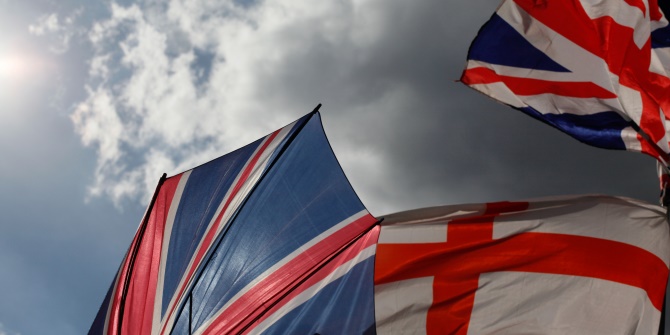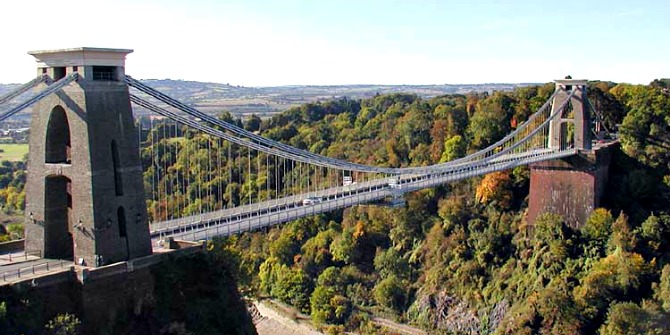 Lord Ashcroft’s latest batch of constituency polls confirmed that the SNP could win more than 50 seats in May. In this post, the team at May2015.com review the available forecasts, many of which imply a smaller – though still substantial – number of seats for the SNP.
Lord Ashcroft’s latest batch of constituency polls confirmed that the SNP could win more than 50 seats in May. In this post, the team at May2015.com review the available forecasts, many of which imply a smaller – though still substantial – number of seats for the SNP.
Ever since Lord Ashcroft released his first round of Scottish polls, May2015 has predicted Scotland’s nationalists would win nearly every seat in Scotland. When Ashcroft’s most recent polls were released we were forecasting 56 seats for the party – a number picked up by the Guardian, the Independent on Sunday, the Daily Record and the Scotsman.
The number was reported as red when it’s incredibly uncertain and based on a limited calculation: we took the swing shown by Ashcroft’s first round of polls and applied it across Scotland. We felt comfortable doing this because a) that swing was extremely similar across the seats Ashcroft polled, b) he polled more than a quarter of Scotland’s seats, c) the swing implied by Ashcroft’s polls was in-line with the swing shown by many Scotland-wide polls conducted since the referendum. We felt even more comfortable doing so after Ashcroft’s second batch of polls showed very similar swings to his first batch.
In his first batch, Ashcroft polled seats more likely to vote ‘Yes’ during the referendum, and therefore perhaps more likely to now support the SNP. In his second batch he polled Labour heartlands like Kirkcaldy, Gordon Brown’s seat, and East Renfrewshire, Jim Murphy’s seat. And he showed a very similar SNP surge. The graph below shows the Labour-to-SNP swing across the 19 Labour seats Ashcroft has now polled (FYI, Labour hold 40 Scottish seats).
In a world of limited data, we thought there was a basis for applying this swing to every seat in Scotland. We did and the model gave us 56 SNP wins. But that prediction isn’t nearly as foolproof as many papers made it sound. Ashcroft himself has offered no such number – although his team are aware of ours and see its logic.
Other forecasts
Indeed not all forecasters agree. The Guardian’s official forecast makes a very similar estimate (unsurprisingly: their recently launched model treats polls in a very similar way to ours), but a pair of academic forecasts – Election Forecast and Elections Etc – have a more conservative, yet still astounding, estimate of around 40 seats.
That’s also where the bookies are. (For those who think the money markets are more accurate than polls, two months ago they were predicting the SNP would win only 25 seats. By May that forecast may have as much as doubled. It’s easy to be right when you’ve offered every prediction at some point.) The point is, SNP predictions really just amount to educated guesswork, even more so than most predictions.
On Monday Nate Silver waded into the UK election by partnering with Election Forecast, after creating his own fairly inaccurate model in 2010. His site – FiveThirtyEight – will soon start making authoritative statements on Scotland, but Silver once highlighted the problem we are all facing in this election: the SNP surge is an ‘out of sample’ event.
We have no historical precedent for the SNP’s rise; the parallel Peter Kellner drew this week with the Irish in the 1870s isn’t exactly data-rich. And we have very few polls on which to base a prediction, unlike in US elections; Silver could add dozens of state-by-state polls to his infamous 2012 forecast every day.
We’re going to try to show some of this uncertainty by running through all 59 of Scotland’s seats. This should identify exactly which seats forecasters disagree over, which ones the SNP are still not favoured to win, and which ones you should watch out for on May 7th.
We hope this list might help on election night as results flood in and broadcasters declare SNP win after SNP win. Was that seat expected to vote SNP? That’s what every broadcaster will need to answer on the night.
How you get to 50 seats
Let’s think of all Scotland’s seats as being in one of five groups: more than 70 per cent likely to vote SNP (“likely”); 60-69 per cent likely (“fairly likely”); 50-59 per cent likely (“lean SNP”); 35-49 per cent likely (“lean Labour”); and less than 35 per cent likely (“unlikely SNP”).
These likelihoods are based on the bookies’ latest odds, as gathered by FPTP. We’re excluding the six seats the SNP already hold and Orkney & Shetland, which has a less than 20 per cent chance of voting SNP and we predict the Lib Dems will win by 13 points in May.
So the SNP start with six seats, with 52 up for grabs. They need to win 44 of them to reach 50 – an arbitrary but psychologically useful totem pole.
First, the SNP need to win the following 13 “likely SNP” seats, in which the bookies give them a more than 70 per cent chance. (We’ve added Election Forecast’s prediction for each seat. All seats are Labour-held unless stated.)
Likely SNP (70+ per cent chance)
- Ochil and South Perthshire — 91% likely to vote SNP
- Dundee West — 100% Ashcroft poll: SNP +34
- Argyll and Bute (Lib Dem-held) — 95%
- Falkirk (Labour seat until whip withdrawn) — 100%
- Inverness Nairn — 100% Ashcroft: SNP +29
- Caithness Sutherland (Lib Dem) — 91%
- Ayshire North — 94%
- Dunbartonshire East (Lib Dem) — 63%
- Cumbernauld — 96% Ashcroft: SNP +18
- Gordon (Lib Dem) — 87% Ashcroft: SNP +17
- Fife North East (Lib Dem) — 93%
- Glasgow East — 82% Ashcroft: SNP +14
- Aberdeenshire West (Lib Dem) — 82% Ashcroft: SNP +14
These seats are ranked in order of how well May2015’s model thinks the SNP will do in them (e.g. we’re predicting a 37-point SNP win in Ochil and a 14-point one in Aberdeenshire West).
Ashcroft has polled six of these seats: Dundee East, Inverness Nairn, Gordon and Glasgow East. He put the SNP ahead in all of them, by between 14 and 34 points.
This makes sense: the equivalent Scottish Parliament seats for Dundee East and Inverness Nairn voted SNP in 2011; Alex Salmond is standing in Gordon; and Ashcroft put the SNP ahead in all seven seats in Glasgow, one of the most economically deprived areas in Scotland and most pro-‘Yes’ areas during the referendum.
All five of Aberdeen and Aberdeenshire’s Scottish Parliament seats voted SNP in 2011, and so did Cumbernauld’s equivalent.
You can see that only one seat stands out on this list: Dunbartonshire East, which Election Forecast thinks Labour has a 34 per cent chance of winning – and just a 3 per cent chance of staying Lib Dem.
The Lib Dems would bristle at that. They are confident Jo Swinson, their MP, will benefit from local support. But let’s give these 13 seats to the SNP. That gives them 19. The Lib Dems have lost six of their eleven seats and Labour have lost five of their 40 (former Labour MP Eric Joyce has also lost his seat).
Fairly likely SNP (60-69 per cent chance)
- Aberdeen North — 48%
- Edinburgh East — 92%
- Livingston — 54%
- Edinburgh West (Lib Dem) — 61%
- Linlithgow and East Falkirk — 80%
- East Kilbride — 66%
- Kilmarnock — 97%
- Glasgow South — 87% Ashcroft: SNP +15
- Edinburgh South West — 70% Ashcroft: SNP +13
- Glasgow North — 79% Ashcroft: SNP +12
- Motherwell and Wishaw — 74% Ashcroft: SNP +11
- Glasgow Central — 75% Ashcroft: SNP +10
- Dunbartonshire West — 70% Ashcroft: SNP +9
We predict that the SNP will win between 30 points (Aberdeen North) and 9 points (Dunbartonshire West) in these seats. But the bookies and academics disagree on most of this group. In nine of them the academies think the bookies are underrating the SNP’s chances, while they think two of them – Aberdeen North and Livingston – are actually toss-ups.
The differences seem to be about how much heed the forecasts pay to Ashcroft’s polls. Ashcroft has polled six of these seats, the last six on the list (numbers 8-13). He put the SNP ahead in them by 9 to 15 points.
But if we ignore the two possible toss-ups and give these 13 seats to the SNP, they are now on 32. Labour have lost another twelve seats; they now have fewer than the SNP and only 23 of the 40 they currently hold. The Lib Dems have lost another and are down to four of their eleven.
Note the uncertainty. According to Election Forecast, we’ve just handed the SNP two seats which are 50:50. And three others – Edinburgh West, Dunbartonshire East, East Kilbride – where there’s a 2:1 chance the SNP don’t win. If we offered you a 2:1 chance of surviving a plane ride, would you board the plane?
Lean SNP (50-59 per cent chance)
- Aberdeen South — 47%
- Stirling — 72%
- Midlothian — 52%
- Lanark and Hamilton East — 53%
- Paisley and Renfrewshire North — 66%
- Ayr, Carrick and Cumnock (Lib Dem) — 66% Ashcroft: SNP +11
- Inverclyde — 83%
- Airdrie and Shotts — 67% Ashcroft: SNP +8
- Glasgow North West — 44% Ashcroft: SNP +6
Again, May2015’s predictions for these nine seats range widely: from a 6-point SNP win (Glasgow North West) to a 29-point one (Aberdeen South). But the bookies think all these seats are about as likely as one another to vote SNP.
The academics disagree. They think Inverclyde is nearly twice as likely to vote SNP as Glasgow North West, and think five of these seats are at least 2:1 to go yellow. And at the other end of things, they don’t back the SNP in two seats: Aberdeen South and Glasgow North West. While they think Glasgow Central, where Ashcroft put the SNP ahead 10, is 75 per cent likely to go SNP, they say Glasgow North West, where Ashcroft put the SNP up six, only has a 44 per cent chance.
Why? Perhaps because their model doesn’t just use Ashcroft and Scotland-wide polls – YouGov provides them with private constituency-level data from their national polls. If we disregard these differences, and give the SNP all nine of these seats, they now have 41. Labour have lost eight; they now have 15. The Lib Dems are down to three.
But we’ve now given the SNP six seats that Election Forecast rates as toss-ups. The two from before (Aberdeen North and Livingston) and four more: Lanark and Hamilton East; Midlothian; Aberdeen South and Glasgow North West. And we’ve handed the SNP all nine of the seats above when the bookies give Labour and the Lib Dems at least a four in ten chance of holding each of them.
This should highlight how the SNP could easily fail to win some of the 41 seats we’ve given them so far. There’s plenty of basis for thinking the SNP will only win 35-40 seats, as many people do.
Seats which ‘lean Labour’ (35-49 per cent chance)
- Edinburgh North and Leith — 42% chance of voting SNP
- East Lothian — 35%
- Edinburgh South — 34%
- Ayrshire Central — 45%
- Dunfermline and West Fife — 6%
- Paisley and Renfrewshire South — 54% Ashcroft: SNP +8
- Kirkcaldy and Cowdenbeath — 46% Ashcroft: SNP +6
- Ross Skye (Lib Dem) — 34% Ashcroft: SNP +5
- Dumfries and Galloway — 13% Ashcroft: SNP +4
- Glasgow South West — 24% Ashcroft: SNP +3
- Coatbridge, Chryston and Bellshill – 29% Ashcroft: SNP +3
- Glenrothes — 61%
- Dumfriesshire (Tory) — 5% Ashcroft: tied
As we’ve noted, there are two camps among forecasters: those who suggest the SNP will win around 40 seats and those who say they’ll win more than 50.
This is where we diverge. We and the Guardian give almost all the seats listed here to the SNP. Election Forecast and Elections Etc don’t. [1] We do because Ashcroft’s polls suggest as much. We are projecting wins as great as 24 points (Edinburgh North and Leith) and as low as 2 (Glenrothes).
The bookies side with the academics and the two agree on about half of these seats. But Election Forecast are doubtful about the SNP’s chances in Coatbridge and in Glasgow South West, and they are very doubtful about the SNP surge in Dumfries, Dumfriesshire and Dunfermline (although they back them in Glenrothes).
This is why Election Forecast’s upper estimate for the SNP is 52. If we give the SNP all the seats we’ve given them so far – which includes six seats Election Forecast rates as toss-ups – we now need to also give them seats like Ross Skye, Edinburgh South and East Lothian, where they only have a one in three chance, to approach 50 seats.
To actually reach 50 seats we need to go so far as to give them Coatbridge, which EF says is more than 70 per cent likely not to vote SNP.
The academics’ model treats Ashcroft’s poll in Coatbridge very lightly (it put the SNP ahead 3), along with his polls in Dumfries (SNP +4), Glasgow South West (SNP +3) and Dumfriesshire (Tory-SNP tie).
The final four seats: ‘unlikely SNP’ (less than 35 per cent chance)
1. Berwickshire, Roxburgh and Selkirk (Lib Dem) – 19%
2. Rutherglen and Hamilton West – 43%
3. Renfrewshire East – 8% Ashcroft: LAB +1
4. Glasgow North East – 2% Ashcroft: LAB +7
There’s less disagreement about these four seats. May2015, Election Forecast and the bookies all say Labour will hold Renfrewshire East and Glasgow North East – although we, following Ashcroft, show them as close races while Forecast give the SNP a less than one in ten chance of winning these seats.
Like us, but unlike the bookies, the academics rate Rutherglen as a close race. They’re less convinced by the SNP’s chances in Berwickshire, which may be the most interesting seat in the UK. It’s a three-way marginal between the SNP, Tories and Lib Dems. (And nowhere in Scotland are Labour more unpopular.) The Lib Dems have held the seat for 50 years. It was the land from which David Steel led the party through Thatcherism.
Now Michael Moore, the Lib Dem and former Secretary of State for Scotland, is hoping incumbency can hold off the Tories and SNP. May2015 will soon be visiting the seat for its latest feature on the seats deciding this election.
As for the SNP, will they win 40 seats or 55? We’ll find out in 54 days.
[1] We can’t be sure of this. Neither the Guardian or Elections Etc publish specific seat numbers. But this seems reasonable given their overall estimates.
Note: This post was originally published on the May2015 website.
Harry Lambert is Editor of the New Statesman’s May2015 site.
Tom Monk is Head of Data and Development at the New Statesman’s May2015 site.









1 Comments